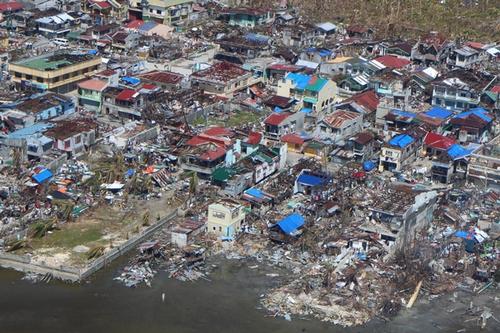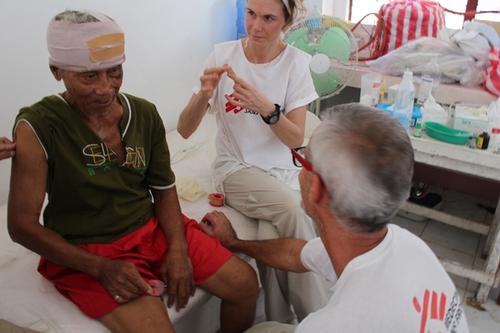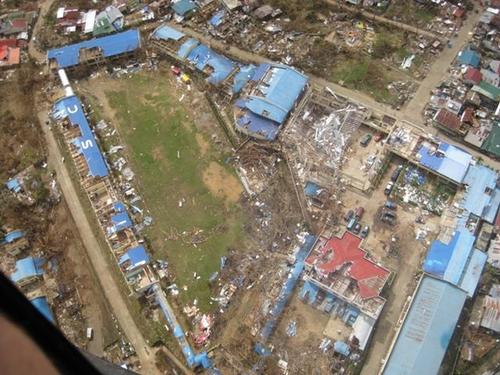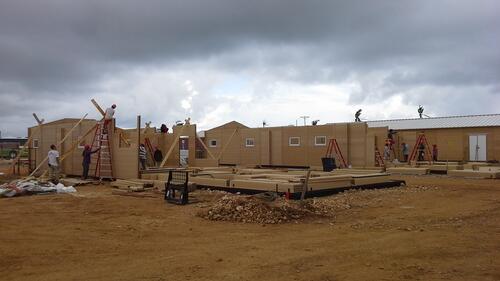MSF team set up medical services and treated patients. Twenty five minor surgeries performed.
Medecins Sans Frontieres’ (MSF) emergency team in the far east of Samar island, where Typhoon Haiyan first struck, is setting up its medical services and seeing patients. The team is creating what will be an integrated provision of mobile clinics, reaching out to the more isolated parts of the coast and islands, and outpatient services in the town of Guiuan itself. The clinic in Guiuan will be able to keep more seriously ill patients overnight.
“Much of the work has involved treating existing wounds which have become infected,” says Dr Johan von Schreeb, who arrived with the team yesterday. “We have done 25 minor surgeries in the past day and the queues are growing with patients suffering pneumonia and diarrhoea.”
Guiuan had almost all of its buildings destroyed and the local hospital is not functioning. The most seriously injured people have now been evacuated. MSF will be providing water and sanitation services as soon as possible and will also assist with shelter. Other members of the team will assess smaller nearby islands by helicopter on Friday, and if conditions allow, soon begin using boats to stage mobile clinics on those islands and along the coast of eastern Samar.
Setting up field hospital
After several days of searching for a way to get teams and supplies to Tacloban, in Leyte Province, a six-person MSF team finally reached the city yesterday and is working to set up a field hospital there in the coming days. The team also visited Palo, southeast of Tacloban, where the hospital has been severely damaged by the typhoon.
MSF staff that assessed Ormoc, in western Leyte, saw a town where most buildings were destroyed and where a hospital that previously had the capacity for 200 beds can now run only a 25-bed emergency department. This team will also assess the area between Ormoc and Tacloban, and another team will assess needs in southern Leyte.
Travelling by helicopter, an MSF team saw that roughly half of Roxas City, in Capiz Province on Panay Island, was significantly damaged. They will carry out additional assessments in the smaller villages surrounding Roxas, while another team, this one consisting of two nurses, a logistician, and a water and sanitation specialist, will fly from Manila to Iloilo, from which they will try to reach San Dionisio, Estancia and Balasan municipalities in northeastern Panay Island.
Efforts limited by logistical impediments
MSF teams are finding their efforts thus far limited by huge logistical impediments that the storm left in its wake. The areas affected by the typhoon are spread out across a very wide area. Many of the main roads and airports in the region are either destroyed, closed, or littered with debris. Some airstrips are too small to land large planes, and electricity and fuel supplies are very limited. Therefore it has been difficult to deliver the cargo necessary, in the amounts necessary, in order to set up programs and provide medical care.
MSF is therefore exploring all possible contingencies and all modes of transport that can get staff and supplies where they need to be to aid those in affected areas, particularly more remote areas further from the centre of the overall relief effort.
'When plan A doesn't work, we move to plan B, or C'
"When we run into an obstacle and plan A doesn't work, we have to move to plan B, or plan C, or in some instances even plan D or E,” says Dr Natasha Reyes, MSF emergency coordinator in Cebu. “We have to think outside the box and be creative, because there are people who need assistance. MSF has been responding to emergencies for a long time, so we've done it before, and we now have to do it again, as quickly as we can."
MSF, for instance, has been able to land cargo planes at the airport in the area’s largest city, Cebu, and to use smaller craft—planes, helicopters, and boats—to send small teams to assess the medical and humanitarian situation in towns and islands in the vicinity.
The nature of MSF’s response will vary from location to location, depending on the setting. But supporting local hospitals, many of which were damaged, is a clear priority, as is running mobile clinics to reach more isolated populations. This may include setting up mobile hubs or “bases” aboard boats that can move from one place to another as needs dictate. In all locations, whatever the obstacles, teams will continue to look for ways to reach those in need.
Latest updates:
- MSF's emergency team in the far east of Samar Island, where the typhoon first struck, is setting up its medical services and seeing the first patients. The team will run mobile clinics to the more isolated parts of the coast and islands, at the same time as running outpatient services in the town of Guiuan itself. The outpatient clinic will have the capacity to keep more serious cases overnight.
- Guiuan had almost all of its buildings destroyed and the local hospital is not functioning. The most seriously injured people have now been evacuated. As well as medical care, MSF teams will be providing water and sanitation services as soon as possible, while assisting with shelter. Other members of the team will also assess smaller nearby islands by helicopter today, Friday, and, if conditions allow, will soon begin using barges and liveaboard dive boats, stocked with medical supplies, to stage mobile clinics on those islands and along the coast of eastern Samar.
- A team of eight MSF staff is in the city of Tacloban, where they are assessing the existing health structures and trying to find a place to set up an MSF-run inflatable field hospital in the coming days. Another team is doing further assessments south of Palo (also on Leyte Island).
- After conducting further assessments in Panay Island, the teams have seen that the eastern part is the most affected. The team is setting up a base in Roxas City to begin activities in the coming days. Also in Panay, following an assessment in Iloilo province, a team will now respond to the acute needs identified in the areas of Estancia, Concepcion and San Dionisio where several thousand houses have been totally destroyed. Some small islands off the eastern coast have also been heavily affected and assessments are currently being carried out there. On the western coast of Panay, the team visited the village of Tibiao where they estimated 60% destruction.
- An MSF team surveyed the northern part of Leyte province. Some health structures have been destroyed. People are walking around with injuries and have not yet received medical care. The team also found people suffering from diarrhoea and pneumonia, related to the shortage of clean drinking water and shelter. MSF is preparing to provide medical care and water and sanitation activities in and around Ormoc, and will expand these activities. Meanwhile, another team is assessing the area to the south between Ormoc and Tolosa.
- Another team based in Ormoc, in Leyte province, are assessing the needs in the rural areas of the south of the island.
- An MSF team has now assessed five small islands southwest of Bantayan Island and is determining what support can be provided.
- An MSF team has also looked further at the needs on Negros Island. The situation is less acute than that being reported in other areas, such as Tacloban, and MSF will not launch activities at this time.
- There are at least five distinct regional targets, where separate MSF teams have been looking at the extent of the medical needs in order to respond with basic care and medical supplies. The nature of that response will vary, depending on the local setting. But high on the list of priorities is support to local hospitals, many of which have been damaged or restricted in their services and which need help to provide essential secondary care.
- MSF is strengthening its overall team (currently 122) and there will be a total of 150 staff – including doctors, nurses, surgeons, logisticians, psychologists and water and sanitation experts – on the ground in the next few days.







